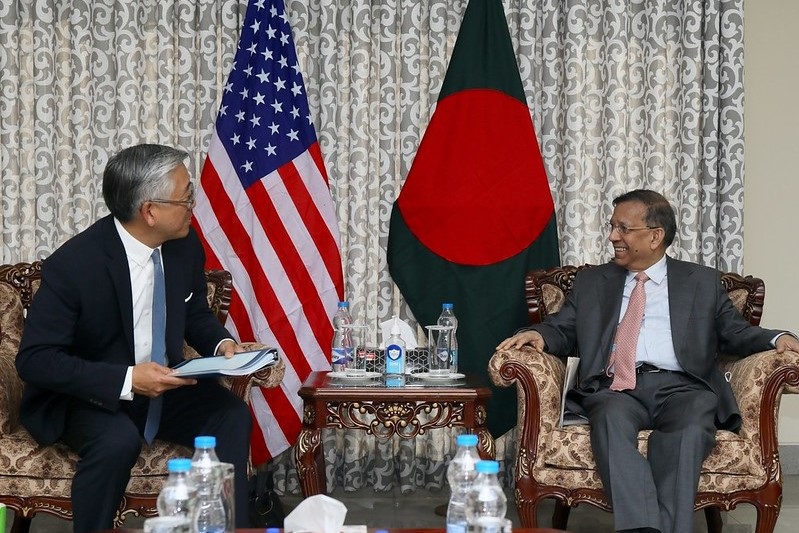
Like many small and middle powers, Bangladesh is hedging its approach to great-power competition in the Indo-Pacific. Despite the release of its first Indo-Pacific outlook in April, Bangladesh continues to shy away from the traditional security issues that are fundamental to furthering the US-led rules-based order.
However, the document provides a promising starting point for the US and partners such as Australia. Supporting Bangladesh to achieve its economic and non-traditional security objectives will further the pursuit of a free and open Indo-Pacific and help to consolidate trust between Dhaka and Washington.
The release of the outlook comes in the context of repeated efforts by the US and others to persuade Bangladesh to join them in promoting a ‘free and open’ Indo-Pacific. Bangladesh’s geostrategic location between China and the Indian Ocean region has prompted a steady series of visits from US officials, such as Assistant Secretary of State for South and Central Asian Affairs Donald Lu in January. Bilateral visits with US partners have similarly increased in pace. In March, the UK’s Indo-Pacific minister, Anne-Marie Trevelyan, travelled to Bangladesh for the first time, and Japanese Prime Minister Fumio Kishida noted in a speech that tapping into the economic potential of Bangladesh aligns with the principle of ‘excluding no one’ in the region.
In this context, the outlook has been perceived by some as a crystallisation of Dhaka’s regional positioning with respect to US–China competition. The document’s release right before Bangladeshi Prime Minister Sheikh Hasina’s 15-day trination tour of Japan, the US and the UK has lent support to this climate of optimism. Although Hasina’s trip included a diverse range of engagements beyond security issues, it could indicate Bangladesh’s desire to engage further with advocates for a free and open Indo-Pacific.
But a closer look at the document’s substance tells a less rosy story. Aside from non-traditional security concerns, the outlook focuses on bolstering Bangladesh’s economic security. One of the objectives set out in the policy is ‘unimpeded and free flow of commerce in the Indo-Pacific’. The focus on prosperity is unsurprising considering Bangladesh’s recent economic growth. The country is on track to graduate from the UN’s list of least developed countries in 2026—and according to the outlook’s first paragraph, Bangladesh wants to become a ‘modern, knowledge-based developed country by 2041’.
But for the US and its partners, Bangladesh’s pursuit of prosperity is complicated by its adherence to a foreign policy of non-alignment. The outlook’s first guiding principle is ‘friendship towards all, malice toward none’. The Bangladeshi Foreign Minister A.K. Abdul Momen reiterated that sentiment following the launch of the document: ‘We are not following anyone. Our IPO is independent’.
One consequence of Bangladesh’s approach of neutrality is close economic engagement with both China and the US. The China–Bangladesh economic relationship has grown significantly, facilitated by its elevation to a strategic partnership of cooperation in 2016 and Bangladesh’s participation in projects under China’s Belt and Road Initiative (BRI), such as the Bangladesh–China–India–Myanmar Economic Corridor. As the US seeks to embed Bangladesh more deeply in its sphere of Indo-Pacific influence, Bangladesh’s close relationship with China will be a significant barrier.
Another inhibiting factor for cooperation is Bangladesh’s lack of an underlying plan to achieve each of the 15 objectives under the outlook. As its name indicates, it is an ‘outlook’ rather than a ‘strategy’ or ‘policy’, and while it articulates the importance of the ‘exercise of freedom of navigation and overflight’ in the region, it establishes no meaningful pathway to achieving that.
With the outlook as a starting point, the US and its partners must work with Bangladesh towards its goals for the collective benefit of the Indo-Pacific. Bangladesh’s desire to engage with both China and the US makes work in areas of traditional security difficult, but Washington and its partners can still assist Bangladesh with the non-traditional security concerns the outlook identifies—including transnational crime, food insecurity and climate change.
Between 1976 and 2019, Bangladesh experienced an average temperature rise of 0.5°C, leading to well-documented impacts including cyclones and floods. Although climate-induced migration is typically internal, interstate migration will increase as the effects of climate change escalate. Deeper engagement with Bangladesh on issues like climate change could help prevent Bangladesh’s entrenchment in China’s sphere of influence.
Despite Bangladesh’s participation in the BRI, Hasina and her government have shown hesitation about the initiative’s future utility. Dhaka is concerned about its mounting debts to Beijing and issues with Sri Lanka’s and Pakistan’s BRI projects. In this precarious moment for Chinese credibility, the US and its partners can step in to provide Bangladesh with alternatives to Chinese investment.
Bangladesh will naturally continue to hedge, but the US and its partners can still deepen cooperation in line with the outlook where possible. This opportunity makes it a welcome regional mechanism for advancing a free and open Indo-Pacific, despite its limitations.

